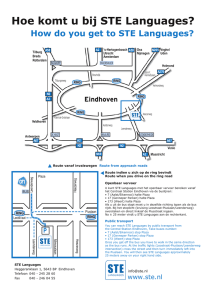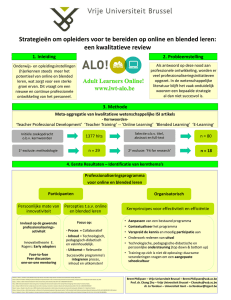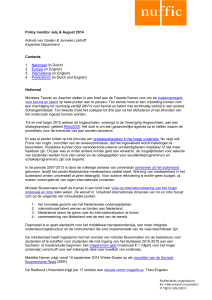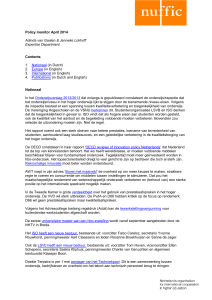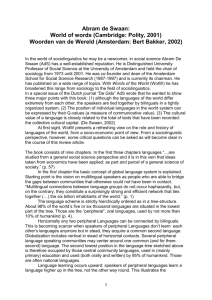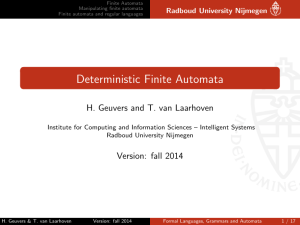language rich school
advertisement
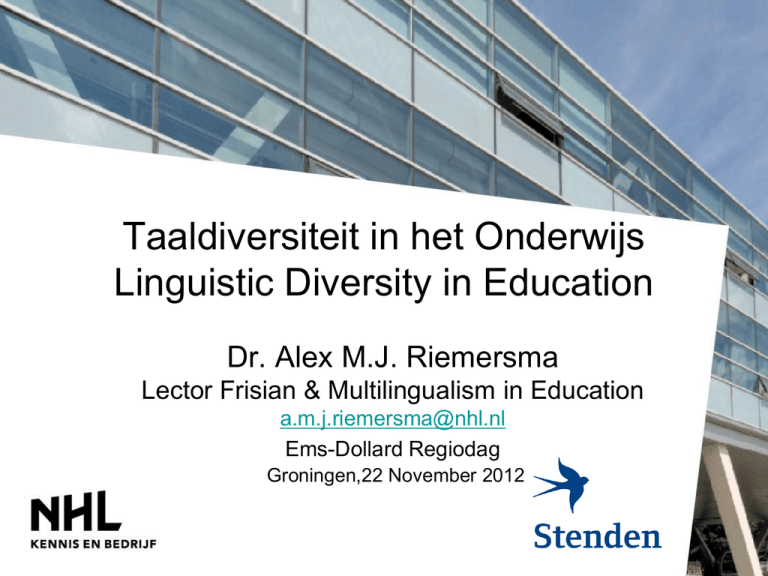
Taaldiversiteit in het Onderwijs Linguistic Diversity in Education Dr. Alex M.J. Riemersma Lector Frisian & Multilingualism in Education a.m.j.riemersma@nhl.nl Ems-Dollard Regiodag Groningen,22 November 2012 Overview • • • • Global Linguistic Diversity Individual bi- and plurilingualism Transfer & Translanguaging Multilingual Education: why, what, how, results • Language Policy at School Startvragen • Waar denkt U aan bij: • • • • Taaldiversiteit in het onderwijs Taalgericht vakonderwijs Meertalig onderwijs Schooltaalbeleid Global Linguistic Diversity • Globe: 6,000 Languages (in oral use) • Unesco Language Vitality Index (2009): more than 2,500 languages (in oral use) endangered / threatened with extinct in 21st century Global Linguistic Diversity • 600 à 700 Languages with basic infrastructure: Orthography, Dictionary, Grammar Book • 475 Languages with complete Bible translation + 1,240 languages with New Testament + 823 languages with (small) part of Bible Unesco Language Vitality Language Vitality factors (6) • Intergenerational transmission • Absolute number of speakers • Proportion of speakers within total population • Trends in existing domains • Response to new domains & media • Materials for Education and Literacy Language Vitality factors (3) • Governmental and Institutional Language Attitudes & Politics • Community Member’s Attitudes towards their own languages • Documentation (& corpus planning) Degrees of Endangerment • 5: safe The language is used by all ages, from children up. • 4: unsafe The language is used by some children in all domains; it is used by all children in limited domains. • 3: definitively endangered The language is used mostly by the parental generation and up. • 2: severely endangered The language is used mostly by the grandparental generation and up. • 1: critically endangered The language is used mostly by very few speakers, of great-grandparental generation. • 0: extinct There exists no speaker. Language Planning Key Words State: Citizen: Capacity Command Opportunities Use Desire / Plan Will International organisations • United Nations (195 member states): 6 working languages: Arabic, Chinese, English, French, Russian, Spanish • Council of Europe (47 member states): 6 working languages: English, French (documents) German, Italian, Russian, Spanish (interpretation) European Linguistic Diversity EU Language Policies • Mother tongue + 2 other languages • Individual Multilingualism as an asset > (2) Mother tongue + 2 (or more) • Lifelong Learning Program (2007-2013) > Erasmus for All (2014-2020) European Policies: EU • European Treaty: “EU respects the religious, cultural and linguistic diversity.” • Definition “Mother tongue” = state language • Principle of “subsidiarity” is in favour of national languages. • “All languages are equal” > “mainstreaming” is in fact in favour of English (only) ! Individual bi- and plurilingualism • 65% of world population uses more than one language in every day life • 10% of EU population speaks a minority language • Millions of migrant language speakers Individual bi- and plurilingualsm • Handicap for happiness? • Asset for successes in: > cognitive > character > communication > culture > career Old theory / ferâldere ideeën 17 New theory / nij ynsjoch 18 Ice berg by Jim Cummins Bilingualism The image of an iceberg is sometimes used to explain the way that bilingual learners’ brains use two languages to make sense of their world (Cummins, e.g. 2005). Reitze Jonkman en Alex Riemersma Lectoraat Fries & Meertaligheid in Onderwijs en opvoeding Triple Ice berg and Common Underlying Proficiency Reitze Jonkman en Alex Riemersma Lectoraat Fries & Meertaligheid in Onderwijs en Opvoeding Why multilingual education? • • • • Mother tongue development Cognitive developments Easier third language acquisition Flexible communication: > social participation > economic success: career & cash • Cultural heritage/language maintenance Foreign language learning • Original status & function: > Elite – mainly in reading and writing > Cultural purposes • Changing towards: > All students and adults: “M + 2” > Global communication – oral use & ict Development of multilingual education in 20th century • Neglect of mother tongue > submersion • Transitional bilingualism > subtractive bilingualism • Equal footing / immersion > additive / full bilingualism Goals of Multilingual Education • Cultural heritage of home language • Transition towards national language versus: • Language maintenance & development • Full bilingualism / biliterate Characteristics of Multilingual Education • Goal oriented > language development > full bilingualism & biliteracy • Subject & use (medium of instruction) • Communication & culture • Continuous curriculum Models of multilingual education • One person / one language > identification with ‘native speaker’ • Split of time > language rich input • Division of subjects > task specific & CLIL: content & language integrated learning • Immersion (in the weaker language) Immersion versus CLIL • Immersion: • from (pre-)school onwards • more than 50% teaching time • native speakers as teachers • CLIL: • Mainly in secondary education • Less than 50% of teaching time • Non-native speakers as teachers Actors at Macro + Meso level • Macro (national and international): conflicting policies • National: stress on national language only discouraging regional and migrant languages • International: EU-/ CoE-policy: mother tongue + 2 • Meso (school level): reflects conflicting policies • Concept of Multilingual Education (ME) fits better to EU- & CoE-policy CLIL & Immersion Reitze Jonkman en Alex Riemersma Bilingual Education in the Netherlands • NO migrant language education • Primary school: English obligatory + 650 schools “Early language learning” • Secondary school: English + one + 160 schools with English – CLIL + 2 schools with German - CLIL Why Language Policy at School? • Changing world(s): mobility & experiences • Position school in multilingual context • Awareness raising on linguistic diversity: minority & migrant languages • Integrated teaching & learning 30 What Language Policy at School? • “Every teacher is a language teacher” • Integrated Teaching & Learning • Comparability of: - teachers’ didactics - students’ results - schools’ results in the region • Visibility of languages: source & target • 31 Language Policy at School • Vision on school as: - “language rich school” / TTO / VVTO - Bi-, tri- or multilingual school • Agreements on language use: - internal communication at school - internal communication in the class room - external communication: orally and in writing (f.e. on the school website) 32 Professional Competencies Language Policy at School • In service training aiming at qualified teachers (competencies) towards: “Every teacher is a language teacher” • Language support for subject teachers (f.e. native speakers) 33 Professional Co-operation Language Policy at School • Transfer: (implicit) use of various languages • Translanguaging: acquisition of knowledge in one language, use and present in another language • CLIL: Content & Language Integrated Learning • Comparison of Languages: grammar, vocabulary, pragmatics 34 Activities on Language Richness of the School • Thematic week on Linguistic Diversity including RMLs & IMLs • Weekly Presentation of a student’s language and its culture • Special activities language acquisition f.e. Language Village 35 Actors for multilingual education • Educational authorities (national, regional, local school board) • School principals & management • Class room teachers • Parents & students • Social and cultural environemnt Micro (school & class room) • Teamwork of teachers of subjects and medium of instruction > integral approach • Common descriptors of language command in the target languages > CEFR + Language Portfolio • Comparable testing methods > student monitoring system • Learning strategies of pupils based on translanguaging and language use Reitze Jonkman en Alex Riemersma Ambitions of lectureship • Continuity of Multilingual Education from primary to secondary education; adequate teacher training • Didactic approach for teacher training: - effective & integrated learning - aiming at results • Language portfolio: - languages integrated - curriculum oriented Reitze Jonkman en Alex Riemersma Ambitions of lectureship • Development of measurement tool for comparable results of language command: - Frisian – Dutch - English; Reference levels: - CEFR: Common European Reference Level (Council of Europe) - DFR: Dutch national reference levels - Anglia-levels / Me!English - Frisia-level Reitze Jonkman en Alex Riemersma CEFR & Anglia Comparative levels Levels DFR & CEFR, Anglia & Frisia DFR CEFR A1 Anglia Frisia Start 1F 2F 3F 4F A2 B1 B2 C1 Junior Intermediate Stap 1 Stap 2 Stap 3 C2 Relevant literature • M. Hajer & Th. Meestringa, Handboek Taalgericht Vakonderwijs. • H. Paus e.a., Dertien doelen in een dozijn. Een referentiekader voor taalcompetenties van leraren in Nederland en Vlaanderen. Nederlandse Taalunie. 42 • Dankuwel • Köszönöm • Dankscheen Tankewol Tankewol • Eskerrik asko • Mercé plan • Graciis • Kiitos • Multimesc • Hvala • Trugarez • Mange Takk • Diolch Tankewol Thank you 43
